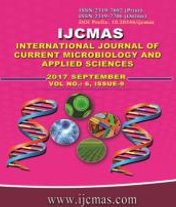


 National Academy of Agricultural Sciences (NAAS)
National Academy of Agricultural Sciences (NAAS)

|
PRINT ISSN : 2319-7692
Online ISSN : 2319-7706 Issues : 12 per year Publisher : Excellent Publishers Email : editorijcmas@gmail.com / submit@ijcmas.com Editor-in-chief: Dr.M.Prakash Index Copernicus ICV 2018: 95.39 NAAS RATING 2020: 5.38 |
The present survey on molluscs pests was conducted at Dharwad and Haveri districts in Karnataka from June, 2015 to January, 2016. During that the major snail noticed was giant African snail (GAS), Achatina fulica Ferussac damaging both forest and horticultural nurseries. The activity of snails in the forest and horticultural nurseries was started during 24th standard week (June 3rd week) of 2015 and persisted up to 2nd standard week of 2016 with peak infestation during 41st standard week (Oct. 2nd week) to 45th standard week (Nov. 2nd week). The highest snail population was recorded in moringa nursery (5.54/4m²) followed by mango (4.79/4m²) in High-Tech Horticulture Unit (HHU) of Dharwad. But in other places the highest number of snail population observed on mango (4.69/4m²) followed by papaya (3.66/4m²) and teak (3.53/4m²). Whereas, the slug incidence was not noticed during the study period. The incidence of snail was positively and significantly correlated with rainfall, relative humidity and minimum temperature irrespective of the nursery plants.
 |
 |
 |
 |
 |